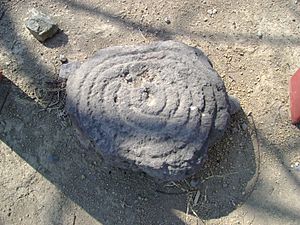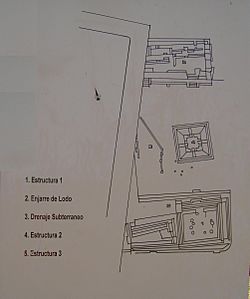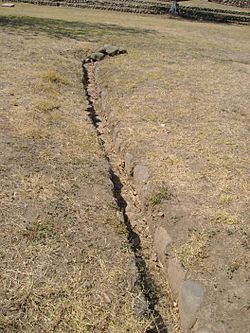La Campana (archaeological site) facts for kids
La Campana is an important ancient site in Colima, Mexico. It's one of the biggest pre-Hispanic cities in western Mexico. Studies show that some parts of La Campana are connected to the famous Teotihuacan culture from the Classic period.
Archaeologists found very old pottery here from the Capacha culture, dating back to about 1500 BCE. The site has special "shaft tombs" (burial places deep underground), pottery offerings, and even old drainage systems for rainwater. There are also ancient streets and a main area for government and religious activities with many monuments. La Campana was opened to visitors in 1995. When the Spanish arrived in 1524, they called the place Almoloyan, which means "place between two rivers."
Contents
Ancient Times in Colima
Long ago, the area of Colima was home to many different groups of people. These groups formed powerful "lordships" (like small kingdoms) and often fought over land. Around the early 1500s, the Purépecha people controlled several areas. The Tecos group owned important salt mines, which led to a "salt war." Their leader, Coliman (or Tlatoani Colimotl), defeated the Tecos. After this war, the Tecos took over more lands and became the strongest group.
Other important ancient sites in the Colima region include:
Capacha Complex
This was a settled group of the Capacha Culture who lived here between 2000 and 1000 BCE. They were farmers and made pottery. This site is about 6 kilometers (3.7 miles) north of Colima city.
Los Ortices Complex
This site dates from 300 BCE to 300 CE. It's located southwest of Colima, near the village of Los Ortices. The people here were more advanced than the Capacha. They made very nice pottery, stone sculptures, and buried their dead in special "shaft tombs," which are common in this region.
Armería & Colima Complex
This group lived between 600 and 1100 CE, east of Colima city. Their crafts were a bit simpler than the others. They made fewer types of pottery and built less refined shaft tombs.
El Chanal Complex
The El Chanal site shows a very unique style for the region. In the mid-1900s, a step pyramid was found here. Later, in the 1990s, archaeologists discovered large open areas, temples, plazas, and a ballgame court. This shows they had a very developed culture. By 1520, El Chanal was no longer a major city, and only smaller groups of people lived there, possibly controlled by a bigger city called Tecomán.
History of La Campana
La Campana started a very long time ago, with traces of Capacha pottery from the early Preclassic period. The main buildings we see today are from the Classic period (100-1500 CE), and the city was most important between 700 and 900 CE.
The city had proper streets, a system to drain rainwater, and a main area for religion and government with many monuments. There were also places where people lived. Their homes were built on platforms, some round and some rectangular, with walls made of cane and adobe (a type of mud brick) and roofs made of palm leaves. This design was good for an area that often has earthquakes.
La Campana grew strong because of its location in the Colima Valley. It was a trading hub where valuable goods, farm products, and raw materials came together from both the west coast and central Mexico. During its most powerful time, it likely controlled smaller towns nearby. Archaeologists think the city declined because of earthquakes that damaged the main ceremonial center. Only a few groups of people remained until 1521.
The site shows all the different ways ancient people built things. They used stones of various sizes from rivers, even distant ones. To build walls, they used clay mixed with plant fibers. The walls were then covered with smooth stucco, which was heated to make it strong and durable.
Language
Much information about the languages spoken here was lost after the Spanish conquest. Some researchers believe the people of La Campana spoke Nahuatl. However, it's thought they also spoke other languages from the Uto-Aztecan language family. This family includes:
- Cora and Huichol
- Nahuatl
- Tohono O'odham, Tepehuán, Tepecano, and Névome
- Nuarijío, Mayo, Tarahumara, and Yaqui
Exploring the Site
La Campana is only a small part of what was once a very important ancient city, possibly called Almoloya. It was a major center for religion, politics, and trade. However, in the 1500s, Franciscan friars (religious leaders) used stones from the ancient platforms to build their own structures. The first official mention of the site was in 1917 by Mr. José María Gutiérrez, who also drew some of the buildings. Dr. Miguel Galindo started exploring one of the buildings in 1922.
Today, the archaeological site covers about 134 hectares (331 acres) between the Colima River and Pereira creek. So far, archaeologists have explored only about 1% of the total area. It has a main administrative and ceremonial center with many buildings. These include rectangular platforms with steps, pyramids that served as foundations for large temples, and courtyards. There are also ancient avenues and many carved stones (petroglyphs) in the courtyards and plazas.
From the center of the site, a 4-meter (13-foot) wide avenue with stone walls leads north. This avenue likely connected La Campana to other settlements, like El Chanal, which is about 3.5 kilometers (2.2 miles) northwest. To the northwest of the site are older housing areas, and to the northeast is a newer part of the site with a small ballgame court.
The way the buildings are placed shows careful planning, like a well-organized city. The main administrative and ceremonial center is very impressive. It has platforms built one on top of another, with temples and homes on them. It also had a system to drain rainwater.
The buildings were made using "round stones" from nearby rivers, joined with clay mortar. The surfaces were covered with a fine stucco that was heated to make it hard and long-lasting. Homes were probably grouped together, separated by cobbled streets. They had different sizes and were roofed with palm leaves and local grasses. Not much pottery has been found, possibly because of looting over the years, but what remains gives interesting clues about this culture.
Many burials have been found during explorations, giving new information about their funeral customs. It's interesting that some skeletons are missing hands, feet, and rib cages.
La Campana was named by its first discoverers because the mound where it was found looked like a bell ("campana" means bell in Spanish). It holds important clues about the ancient cultures of western Mexico. It dates back to around 900 BCE.
Site Description
The part of La Campana explored first (in 1995) is in a plaza with a system of drainage wells to remove rainwater. It includes Structure 1, which has platforms built one on top of another. In front, there's a staircase decorated with stone blocks. At the top is a large building with circles inside, possibly used to store grains or the ashes of important people. In the center is a pyramid altar. Its shape, with three stepped platforms, looks like the nearby Fuego Volcano, suggesting the volcano was important to their religion. Human remains were found on both sides of this structure.
Another building, also on platforms, has two entrances to the top and rooms defined by walls. It's thought these were used for private religious ceremonies by priests.
Buildings found in 1996 are on a huge plaza, higher than the 1995 section. They were built with stone and dirt over older structures. This area has two large platforms facing east–west, with altars and small ceremonial rooms. Simple offerings were found here.
On the eastern side are two large pyramid-like structures. The one in the middle has three levels (the fourth was lost to a modern building). It has a rectangular base, 25 meters (82 feet) on each side, with a central stairway and side walls. It combines sloped walls with passages between its different parts. At the top was a compound or altar where priests likely performed rituals, based on the many offerings found.
The other building has large sloped walls, parts of which were found in 1996. Between these two buildings, a ballgame court was built. It has a narrow court, facing east–west, with sloped side walls and a vertical section on top.
Important items related to ancient beliefs about life after death were found. Several shaft tombs were discovered with various offerings, both for daily life and ceremonies, meant to go with the deceased on their journey to the underworld.
Like many sites in the region, La Campana has shaft tombs. One, Tomb No. 7 near Structure 6, has a vault where human body fragments were buried. It also has a stepped corridor and major offerings, including a dog and a clay mask.
Structure 1
This large structure is south of the main plaza. Its rectangular base is 52 by 36 meters (170 by 118 feet). It's built with platforms stacked on top of each other. At the top is a rectangular temple with several circles inside, possibly for storage. You can access it by wide stairs decorated with four stone blocks. The steps have different heights, with the first ones much taller.
Even after the city declined, people continued to use this place for worship, as shown by the human remains found.
This structure was covered in stucco, a smooth plaster made from cooked clay, on its walls and floors. The stucco might have had painted designs using natural colors from the region. You can still see samples of this stucco at the bottom of the eastern entrance to Structure 3. You can also see tiny bits of plant fibers mixed with the adobe.
Structure 2
This building is in the center of the plaza, measuring 20 by 20 meters (65 by 65 feet) at its base. Its unique shape and slender look are typical of Colima architecture. It was built on three square, stepped platforms. It has beautiful sloped sides with four staggered entrances that lead to the square platform at the top. Burials were found at its base.
Underground Drainage
Next to Structure 2 are some carved stones (petroglyphs). In this area, you can see parts of the underground drainage system. This system was built to collect and remove rainwater. It was originally covered with stones and followed the layout of the buildings.
Structure 3
This structure is northwest of the plaza, with a base of 43 by 9 meters (141 by 29 feet). It's large and built with stacked, stepped platforms, similar to Structure 1. It has two entrances to the top, but its height is less than 3 meters (10 feet). There are holes at its base, possibly for holding water or storage.
Structure 4
Located southeast of the plaza, its base is 60 by 24 meters (197 by 79 feet). It's a large building with stacked, stepped platforms. It has three different ways to reach the top and a good system for draining rainwater. It seems this area was likely where important or noble people lived.
Structure 4 has 11 medium-sized rooms, probably with palm leaf roofs supported by wooden columns.
It connects to Structure 5, and in front of Structure 4, there's a small plaza and a sun clock at the entrance of Structure 5.
Structure 5
This pyramid-shaped building dominates the city layout, with a base of 26 by 31 meters (85 by 102 feet). It's a great example of ancient monumental architecture, showing the hard work and artistic skill of its builders. The original structure had several levels stacked on top of each other, but only three remain today. A temple once stood on top of its impressive base. Inside, there's another, older building. Later changes are visible on the left side of the building.
Structure 6
This building is known for its huge sloped walls and corridors that create different sections. Its shape and direction follow ancient Mesoamerican ideas about astronomy, religion, and geometry. At its top, there are large plazas. The lower part of the temple has stepped entrances, and priests probably used this place for their rituals. Its orientation allowed people to observe the sunrise and sunset. It was used and changed by some later ancient groups. Its base measures 24 by 16 meters (79 by 52 feet).
Ballgame Court
Located between Structures 5 and 6, this court measures 16 by 8 meters (52 by 26 feet). It's a rectangular court, facing east–west, and bordered by two important side structures. This place was used to play Tlalchi, a ritual ballgame. This game had a special meaning related to fertility and political-religious importance. Even after the city was abandoned, this place continued to be used for worship.
Structure 11
This is a pyramid temple with a square base and four stepped entrances, measuring 24 by 9 meters (79 by 29 feet). Its direction follows architectural rules based on geometric shapes, astronomical elements, and the meaning of the cardinal directions. At the top was a small platform where political and religious ceremonies took place.
Archaeologists found two main building stages for this structure. The first was during the Classical period (100 BCE to 500 CE). Later, changes were made between 700 and 900 CE.
Structure 12
This is a platform that sticks out significantly, as it defines the central plaza and also connects to another plaza in the north. Rooms and temples were built on it. Based on what was found, it's believed this platform was used as living quarters for those involved in religious worship.
Cascabel Pyramid
This structure has a carved stone rattlesnake ("Cascabel" means rattle) at the bottom of its first entrance. This snake is a symbol connected to the worship of water. The snake was part of the water god (Tlaloc) and was linked to clouds, rain, and lightning. Tlaloc was thought to be a fire snake that moved through the region and sank into the ground when it fell. Similar snake carvings are found in temples of the Teotihuacan culture.
Images for kids
See also
 In Spanish: La Campana (Colima) para niños
In Spanish: La Campana (Colima) para niños












